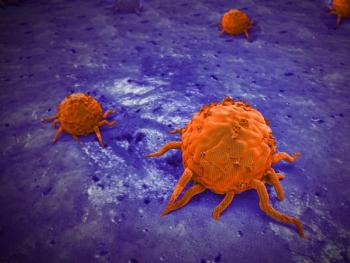
Oncology NEWS International
- Oncology NEWS International Vol 17 No 6
- Volume 17
- Issue 6
NELSON trial sails on toward final results in 2015
CHICAGO-Baseline and second-round screening results from the Dutch-Belgian NELSON randomized CT lung screening trial show a low rate of positive tests: 2.6% on baseline screening and 1.8% on second-round screening. This could make low-dose CT screening “more acceptable to the public and suitable for mass screening programs,” said Rob J. van Klaveren, MD, PhD, of Erasmus Medical College, Rotterdam. Dr. van Klaveren reported the results at ASCO 2008 (abstract 1508).
ABSTRACT: Baseline and second-round screening results show a low rate of positive tests: 2.6% at baseline and 1.8% after the second round.
CHICAGO-Baseline and second-round screening results from the Dutch-Belgian NELSON randomized CT lung screening trial show a low rate of positive tests: 2.6% on baseline screening and 1.8% on second-round screening. This could make low-dose CT screening “more acceptable to the public and suitable for mass screening programs,” said Rob J. van Klaveren, MD, PhD, of Erasmus Medical College, Rotterdam. Dr. van Klaveren reported the results at ASCO 2008 (abstract 1508).
NELSON is the only CT lung cancer screening trial in which patients have been recruited using a population registry and the only randomized lung cancer screening trial with no screening in the control arm. Screening began in 2004; interim results are expected in 2009, with final results in 2015. The trial enrolled individuals aged 50 to 75 years who were smokers or ex-smokers who had stopped smoking for less than 10 years.
Screening results
Of 7,556 subjects with baseline scans, 51% had at least one nodule: 79.1% were negative, 19.3% indeterminate, and 1.6% positive. Based on repeat scans of these nodules at 3 months, 96.6% were negative, 1.8% indeterminate, and 2.6% positive.
Second-round screening results at 1 year (n = 7,264) showed 2,313 new nodules: 92.1% were negative, 6.6% indeterminate, and 1.3% positive. Based on 6-week and 1-year repeat scans, “the test eventually became negative in 97.2%, 1% remained indeterminate, and 1.8% became positive,” Dr. van Klaveren said.
The lung cancer prevalence rate at baseline was 0.9%, with 25 patients (0.3%) undergoing resection for a benign lesion. This represented 30% of resections. “It’s important to realize that not all resections for benign lesions were futile,” Dr. van Klaveren said. He pointed out that a large number of nonmalignant diagnoses could be made only at resection, eg, hamartomas, granulomas, sarcoidosis, tuberculosis, and fungal infections.
At first-line screening (baseline and 3-month repeat), 72 cancers were found, with 53 found in the second screening round. “The majority of the nodules originated from previously existing nodules at subsequent repeat scans, and very few cancers originated from new nodules,” Dr. van Klaveren said.
Most cancers stage I
Of the cancers detected in the first round, 72.9% were resectable (64% stage I) and in the second round, 80% were resectable (74% stage I).
Baseline screening had a sensitivity of 92% and specificity of 98%, with a positive predictive value of 39% and a negative predictive value of 99.9%.
Articles in this issue
over 17 years ago
Who’s responsible for safety of outsourced drugs?over 17 years ago
New GnRH blocker degarelix quickly suppresses levels of testosteroneover 17 years ago
Evaluating lung cancer response to therapy: Thinking beyond RECISTover 17 years ago
Novel breast probe reduces repeat surgeriesover 17 years ago
Radioactive microspheres benefit liver met ptsover 17 years ago
INTORACT trial of Torisel/Avastin in RCC is initiatedover 17 years ago
New codes needed for chronically ill ptsNewsletter
Stay up to date on recent advances in the multidisciplinary approach to cancer.



















































































